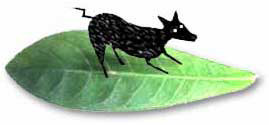HERBAL THERAPY
INTRODUCTION
 The early 90's seemed
hopeful for the merging of western and alternative medicine in the
Philippines. There was a burgeoning global movement towards alternative
therapies, a new-age allure for "natural" remedies; and
in the Philippines, the beginnings of herbal medicinal research &
development. In 1992, during the term of Juan Flavier as Secretary
of Health, a brochure of 10 medicinal plants (akapulko,
ampalaya, bawang, bayabas, lagundi, niyog-niyogan, pansit-pansitan,
sambong, tsaang-gubat, yerba buena) for common health problems
was published and commercial production was =pursued. In 1997, the
TAMA (Traditional and Alternative Medicine Act) was passed, providing
a legitimizing boost to the alternative medicine movement in the Philippines.
. . .(More)
The early 90's seemed
hopeful for the merging of western and alternative medicine in the
Philippines. There was a burgeoning global movement towards alternative
therapies, a new-age allure for "natural" remedies; and
in the Philippines, the beginnings of herbal medicinal research &
development. In 1992, during the term of Juan Flavier as Secretary
of Health, a brochure of 10 medicinal plants (akapulko,
ampalaya, bawang, bayabas, lagundi, niyog-niyogan, pansit-pansitan,
sambong, tsaang-gubat, yerba buena) for common health problems
was published and commercial production was =pursued. In 1997, the
TAMA (Traditional and Alternative Medicine Act) was passed, providing
a legitimizing boost to the alternative medicine movement in the Philippines.
. . .(More)
LISTS OF HERBAL
MEDICINAL PLANTS TheTagalog list of Philippine mediicinal plant entrees now
number over 900. There is an English list for plants with English
designations. Recently added is a list of Philippine medicinal plants
with known Chinese names. Frequent updating is done as additional
information on scientific studies is acquired and new digital photos
become available as the serendipity of the seasons provide opportunities
to rediscover the plants in their blooming, budding, podding and flowering
stages . . . (More)
PLANT
NAMES
 A
study of Philippine medicinal plants is a journey into a world of
confusing nomenclatures. Well, perhaps not so confusing to the serious
student of botany, who may actually feel comfortable traversing the
landscape of Latin names (or Greek or other tongue-twisting source).
But for the occasional plant dabbler, for the weekend gardener, or
for the occasional query and foray into the world of Philippine herbal
plants, it is quite an unfriendly and intimidating gumbo of Latin
and a dizzying variation of local names. . .(more)
A
study of Philippine medicinal plants is a journey into a world of
confusing nomenclatures. Well, perhaps not so confusing to the serious
student of botany, who may actually feel comfortable traversing the
landscape of Latin names (or Greek or other tongue-twisting source).
But for the occasional plant dabbler, for the weekend gardener, or
for the occasional query and foray into the world of Philippine herbal
plants, it is quite an unfriendly and intimidating gumbo of Latin
and a dizzying variation of local names. . .(more)
HERBAL
SEARCH 
If Latin or Greek is intimidating, the lists for Philippine common
names can be downright migrainous. Many common names are shared by
the plants from a different Family or Genus. A plant can have a variety
of common names from the same region. I≠≠t is not uncommon for a plant
to run a list of 10 to 15 names; some in extremely confusing numbers
that can run up to more than 30 common names; ex: alagasi, 36; anagiong,
37. The search engine can be an invaluable tool to help you foray
through this unfriendly haystack of names. With the scientific names
and English names on hand, it can be extremely helpful. . . (More)
NAMES NEEDED
 The search for medicinal plants to photograph and accompany botanical
texts and alternative info has led to an increasing accumulation of
unused digital photos of plants that failed to fit botanical info.
A plant or two will be featured regularly. If any of them should tweak
your botanical chords, please email the info: scientific or common
names or folkloric use. (More)
The search for medicinal plants to photograph and accompany botanical
texts and alternative info has led to an increasing accumulation of
unused digital photos of plants that failed to fit botanical info.
A plant or two will be featured regularly. If any of them should tweak
your botanical chords, please email the info: scientific or common
names or folkloric use. (More)









